
Helsinki is the capital and most populous city in Finland. It is on the shore of the Gulf of Finland and is the seat of southern Finland's Uusimaa region. About 682,000 people live in the municipality, with 1.26 million in the capital region and 1.6 million in the metropolitan area. As the most populous urban area in Finland, it is the country's most significant centre for politics, education, finance, culture, and research. Helsinki is 80 kilometres (50 mi) north of Tallinn, Estonia, 360 kilometres (220 mi) north of Riga, Latvia, 400 kilometres (250 mi) east of Stockholm, Sweden, and 300 kilometres (190 mi) west of Saint Petersburg, Russia. Helsinki has significant historical connections with these four cities.

Hakaniemi is an unofficial district of Helsinki, the Finnish capital. It covers most of the neighbourhood of Siltasaari in the district of Kallio. Hakaniemi is located at the sea shore and is separated from the city centre by the Siltavuorensalmi strait and from the district of Linjat by the street Hämeentie. Historically, Hakaniemi was often associated with the working class and workers' associations. However, the cost of living has risen considerably in recent years and is now on par with that of the rest of central Helsinki.
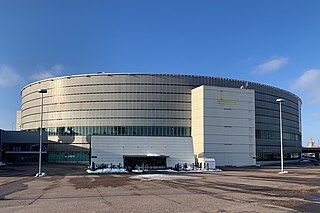
Helsinki Halli is a large multi-functional indoor arena located in Helsinki, Finland. It was opened in April 1997. The arena is convertible for various events. The total seated capacity during ice hockey games is 13,349 and as an amphitheatre, it is significantly reduced to between 3,000 to 5,000.
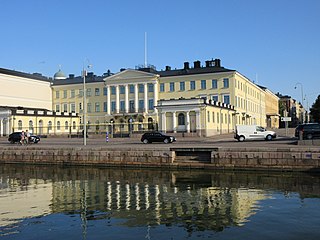
The Presidential Palace is one of the three official residences of the president of the Republic of Finland. It is situated in Helsinki, on the north side of Esplanadi, overlooking Market Square.

Pasila is a part of Helsinki, Finland, that is both a central-northern neighbourhood and district, bordering the areas of Alppila to the south, the Central Park (Keskuspuisto) to the west, and Vallila to the east.
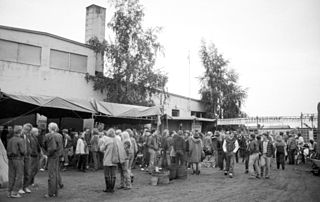
Lepakko or Lepakkoluola was a self-managed social centre and a music venue in Ruoholahti, Helsinki, Finland, functioning from 1979 to 1999.

Keilaniemi is a district in the south-eastern part of Espoo, Finland.

Munkkiniemi is a neighbourhood in Helsinki. Subdivisions within the district are Vanha Munkkiniemi, Kuusisaari, Lehtisaari, Munkkivuori, Niemenmäki and Talinranta.

Pikku Huopalahti is a neighbourhood in the West of Helsinki between the Ruskeasuo neighbourhood and Mannerheimintie in the east, the Meilahti neighborhood in the South, the Niemenmäki neighborhood and Huopalahdentie street in the West and the Vihdintie street and Etelä-Haaga neighborhood in the North.

Helsinki Velodrome is an outdoor velodrome, American football and field hockey stadium in Helsinki, Finland. The protected functionalist concrete building was designed by Hilding Ekelund.
Aino Nykopp-Koski is a Finnish serial killer. She worked as a nurse and was found guilty of killing five patients and the attempted murder of five more. No motive was established for the murders.

Serpentine House is a modernist apartment building complex on Mäkelänkatu in the Käpylä district of Helsinki, Finland. The complex was designed by Yrjö Lindegren and opened in 1952. It is owned by the City of Helsinki apartments company and comprises 189 rental apartments in two four-storey buildings. A two-storey service building houses a day-care center and a swimming hall. The apartment buildings also include some commercial space. The complex gets its name from the twisty form of the buildings.
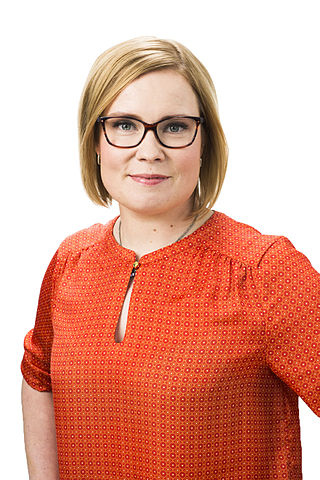
Laura Kaarina Räty is a Finnish politician, former Minister of Social Affairs and Health and a business director at the Finnish private hospital corporate group Terveystalo.
The Pikku Huopalahti dumping ground was a dumping ground in Pikku Huopalahti, Helsinki between 1937 and 1949.
The COVID-19 pandemic in Finland has resulted in 1,499,712 confirmed cases of COVID-19 and 11,466 deaths.
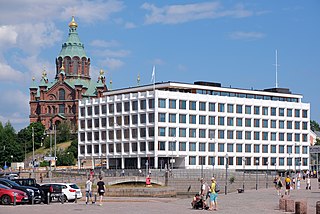
The Stora Enso headquarters is an office building located in the Katajanokka neighbourhood of central Helsinki, Finland, completed in 1962. It is notable for having been designed by the Finnish architect Alvar Aalto.
Mehiläinen is a concern for social and healthcare services for both public and private customers, active in Finland, Sweden, Germany and Estonia. The company's largest owner is CVC Capital Partners.

The Töölö Hospital was a hospital in Taka-Töölö, Helsinki, Finland, belonging to the Helsinki University Central Hospital. It had special departments for plastic surgery, orthopedic surgery and traumatology, hand surgery and neurosurgery. The hospital had a 24-hour policlinic receiving trauma patients from the Helsinki capital area and occasionally from the entire region of Southern Finland. Patients usually arrived at the policlinic on a medical note. The policlinic treated about 18 thousand patients per year. The hospital also hosted the cleft lip and cleft palate centre HUSUKE, containing research and care for cleft lips and cleft palates as well as the department for care of mouth and jaw diseases. The Töölö Hospital also had its own X-ray facility and laboratory.
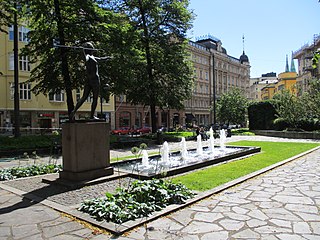
Kolmikulma, also known as the Diana Park, is a small, rectangular triangular-shaped park located in the Kaartinkaupunki district in the city center of Helsinki, Finland. It is limited by the Yrjönkatu, Uudenmaankatu and Erottajankatu streets. The park was renovated in 2006 and 2007.

The Helsinki Surgical Hospital, often referred to as Kirurgi or simply Kirra, is a hospital located in Helsinki, Finland, in the district of Ullanlinna along the street Kasarmikatu near the Tähtitorninmäki park. The hospital was built in 1888 and represents neoclassical architecture typical of the late 19th century. The hospital is part of the Helsinki University Central Hospital.
















